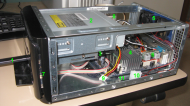In case you were interested in my FreeNAS setup so far:
 A NAS server for my home
A NAS server for my home1 - 1GB flash drive with embedded
FreeNAS OS, takes almost exactly 5 minutes to boot to a working system, probably because there are no EHCI USB drivers loaded so it's stuck at USB1.1 speeds until the OS is running.
2 - Old LiteOn IDE DVD-ROM initially used for loading FreeNAS onto the flash drive. Could probably replace it with a HDD or just remove it.
3 - Old 160GB WD SATA HDD being used until I can afford or scrounge a bigger HDD.
4 - VIA
SP8000EG EPIA motherboard with embedded 800MHz Eden CPU.
5 - Cooling fans, basically a
HDD cooler cut down and then stuck in place with double-sided tape. Also has the power input from a 44W 12V external PSU.
6 -
120W Wide Range PicuPSU, handles 12-25V input. Probably the smallest ATX PSU you'll find, plus it's silent.
7 -
Aywun MI-008 Mini-ITX case. Normally has a 200W SFF PSU but that's a bit of overkill since the case is designed for EPIA or Atom based boards.
8 - Empty coffee cup.
9 - The PicoPSU has 1xMolex, 1xSATA and 1xFloppy power connector, I'll be changing the floppy one for a SATA connector.
10 - Power plug for the fans, I'll be changing it to run them off of 7V so they'll still be silent.
11 - A second HDD can be fitted vertically in the rails here.
The SP8000EG only has 2 SATA ports but I already had it sitting around, power usage for it is 12W idle and 18W full load. So adding in a pair of 2TB, (or even the new 3TB HDDs), will add 12W - so the total system power will be approximately 12-14W under the power rating of the 12V external PSU. Not bad considering the D-Link DNS-313 comes with a 36W 12V PSU.
If I was starting from scratch then I'd probably go for an Intel Atom based board like the
GIGABYTE GA-D525TUD for more SATA ports and internal Gb LAN.
